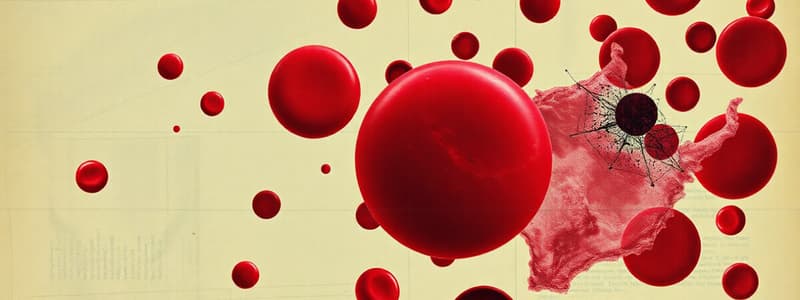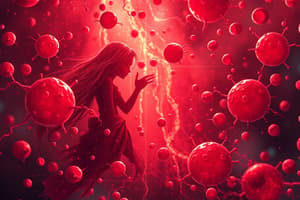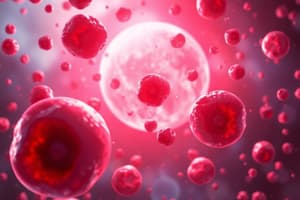Podcast
Questions and Answers
What condition is indicated by microcytic hypochromic red cells?
What condition is indicated by microcytic hypochromic red cells?
- Iron deficiency anemia (IDA) (correct)
- Sickle cell disease
- Vitamin B12 deficiency
- Thalassemia
What characteristic does the central pallor of a red blood cell depict in cases of hypochromia?
What characteristic does the central pallor of a red blood cell depict in cases of hypochromia?
- Increased cell volume
- Lack of hemoglobin (correct)
- Healthy red cell functioning
- Excessive iron content
Which of the following is a visual representation used to identify features in blood film preparation?
Which of the following is a visual representation used to identify features in blood film preparation?
- MRI scan
- SEM photograph (correct)
- CT scan
- X-ray
What is one of the causes of impaired hemoglobin synthesis?
What is one of the causes of impaired hemoglobin synthesis?
In what scenario might microcytes be observed in a blood film?
In what scenario might microcytes be observed in a blood film?
What does the term 'microcytic' refer to in the context of red blood cells?
What does the term 'microcytic' refer to in the context of red blood cells?
What could contribute to decreased hemoglobin production?
What could contribute to decreased hemoglobin production?
Which process is NOT related to impaired hemoglobin synthesis?
Which process is NOT related to impaired hemoglobin synthesis?
In the context of impaired hemoglobin synthesis, what does 'microcytes' refer to?
In the context of impaired hemoglobin synthesis, what does 'microcytes' refer to?
What is a major consequence of ineffective iron utilization?
What is a major consequence of ineffective iron utilization?
What can happen to granules when stained?
What can happen to granules when stained?
How can granules affect the appearance of the cytoplasm?
How can granules affect the appearance of the cytoplasm?
What characteristic do granules have that affects staining?
What characteristic do granules have that affects staining?
Which factor may result in granules obscuring the nucleus?
Which factor may result in granules obscuring the nucleus?
What is a possible outcome when granules wash out during staining?
What is a possible outcome when granules wash out during staining?
What type of antibodies are usually involved in cold agglutination?
What type of antibodies are usually involved in cold agglutination?
Which condition is NOT commonly associated with cold agglutinin?
Which condition is NOT commonly associated with cold agglutinin?
What effect does warming a sample to 37℃ have on agglutination?
What effect does warming a sample to 37℃ have on agglutination?
In the presence of cold agglutination, what happens to RBC and hematocrit readings?
In the presence of cold agglutination, what happens to RBC and hematocrit readings?
What is the significance of a high MCHC value in cases of cold agglutination?
What is the significance of a high MCHC value in cases of cold agglutination?
Which of the following descriptions is accurate for ovalocytes?
Which of the following descriptions is accurate for ovalocytes?
What condition is commonly associated with the presence of elliptical shaped red blood cells?
What condition is commonly associated with the presence of elliptical shaped red blood cells?
Which characteristic is true for elliptocytes?
Which characteristic is true for elliptocytes?
Which of the following conditions is NOT linked to ovalocytes?
Which of the following conditions is NOT linked to ovalocytes?
What causes the formation of elliptocytes in blood?
What causes the formation of elliptocytes in blood?
What characterizes the Alder Reilly Anomaly?
What characterizes the Alder Reilly Anomaly?
Which of the following white blood cells can exhibit heavy azurophilic granules in Alder Reilly Anomaly?
Which of the following white blood cells can exhibit heavy azurophilic granules in Alder Reilly Anomaly?
Which statement is true regarding the granules in Alder Reilly Anomaly?
Which statement is true regarding the granules in Alder Reilly Anomaly?
Which types of cells may NOT show heavy granulation in Alder Reilly Anomaly?
Which types of cells may NOT show heavy granulation in Alder Reilly Anomaly?
In which of the following conditions is Alder Reilly Anomaly most likely observed?
In which of the following conditions is Alder Reilly Anomaly most likely observed?
Flashcards
Red Blood Cell Agglutination
Red Blood Cell Agglutination
A condition where red blood cells clump together in the blood sample due to the presence of antibodies (usually IgM and complement) in the patient's plasma.
Cold Agglutinins
Cold Agglutinins
Antibodies that cause red blood cells to clump together at cold temperatures.
Paroxysmal Cold Hemoglobinuria
Paroxysmal Cold Hemoglobinuria
A disease characterized by red blood cell destruction due to cold temperatures, often triggered by cold exposure.
False Low RBC Count and Hematocrit
False Low RBC Count and Hematocrit
Signup and view all the flashcards
Falsely Elevated MCHC
Falsely Elevated MCHC
Signup and view all the flashcards
Impaired Hemoglobin Synthesis
Impaired Hemoglobin Synthesis
Signup and view all the flashcards
Ineffective Iron Utilization, Absorption, or Release
Ineffective Iron Utilization, Absorption, or Release
Signup and view all the flashcards
Decreased or Defective Globin Synthesis
Decreased or Defective Globin Synthesis
Signup and view all the flashcards
Microcytes
Microcytes
Signup and view all the flashcards
Figure 5-8 Correlation of Microcytes to Pathologic Processes
Figure 5-8 Correlation of Microcytes to Pathologic Processes
Signup and view all the flashcards
Hypochromia
Hypochromia
Signup and view all the flashcards
Iron Deficiency Anemia (IDA)
Iron Deficiency Anemia (IDA)
Signup and view all the flashcards
Scanning Electron Microscopy (SEM)
Scanning Electron Microscopy (SEM)
Signup and view all the flashcards
Blood Film
Blood Film
Signup and view all the flashcards
Ovalocytes
Ovalocytes
Signup and view all the flashcards
Elliptocytes
Elliptocytes
Signup and view all the flashcards
Hereditary Ovalocytosis
Hereditary Ovalocytosis
Signup and view all the flashcards
Hereditary Elliptocytosis
Hereditary Elliptocytosis
Signup and view all the flashcards
Thalassemia
Thalassemia
Signup and view all the flashcards
Alder Reilly Anomaly
Alder Reilly Anomaly
Signup and view all the flashcards
Neutrophils
Neutrophils
Signup and view all the flashcards
Eosinophils
Eosinophils
Signup and view all the flashcards
Basophils
Basophils
Signup and view all the flashcards
Lymphocytes
Lymphocytes
Signup and view all the flashcards
Granule Obscuration
Granule Obscuration
Signup and view all the flashcards
Granule 'Wash Out' During Staining
Granule 'Wash Out' During Staining
Signup and view all the flashcards
Granule Interference
Granule Interference
Signup and view all the flashcards
Empty Areas in Cytoplasm
Empty Areas in Cytoplasm
Signup and view all the flashcards
Staining Impacts Granule Visualization
Staining Impacts Granule Visualization
Signup and view all the flashcards
Study Notes
Evaluation of Red Cell Morphology & Introduction to Platelets & White Cell Morphology
- Objectives: Discuss hematology stains, identify normal red blood cell morphology, define anisocytosis and poikilocytosis, define normochromic, hypochromic, microcytic, and macrocytic as they relate to red cell indices, correlate red cell indices with red cell morphology, define RBC morphological abnormalities and the most common RBC inclusions on a peripheral blood smear, list conditions showing leukocyte morphological abnormalities on a peripheral blood smear, and describe normal and abnormal platelet morphology on a peripheral blood smear.
Peripheral Blood Smear
- Reasons: Perceived clinical features, abnormalities in CBC, detection or verification of abnormalities, and information for differential diagnosis.
- Advantages: Detect or verify abnormalities, and provide information for differential diagnosis.
- Components: Red blood cells (size, shape, distribution, hemoglobin concentration, color, inclusions), platelets (count, shape, size, clumping), and white blood cells (differential, nuclear abnormalities, cytoplasmic abnormalities, abnormal inclusions).
Hematology Stain
- Nonvital (dead cell) polychrome stain (Romanowsky): Most commonly used routine peripheral blood smear stain. Wright's stain contains methylene blue (stains acidic components like DNA and RNA blue), eosin (stains basic components like hemoglobin red-orange), and methanol fixative.
- Staining Process: Staining does not begin until a phosphate buffer (pH between 6.4 and 6.8) is added.
- Causes of Staining Issues: Causes of RBCs appearing too red/WBC nuclei poorly stained include buffer or stain below pH 6.4, excess buffer, decreased staining time, increased washing time, thin smear, expired stains. Causes of RBCs and WBC nuclei appearing too blue include buffer or stain above pH 6.8, too little buffer, increased staining time, poor washing, thick smear, increased protein, or a heparinized blood sample.
Nonvital Monochrome Stain
- Prussian blue (Perl's Test): Stains specific cellular components, used to visualize iron granules (siderotic iron granules) in red blood cells (RBCs), histiocytes, and urine epithelial cells.
Supravital (living cell) Monochrome Stain
- Used to stain specific cellular components without fixatives.
- Examples: New methylene blue to precipitate RNA in reticulocytes (measuring bone marrow erythropoiesis), and neutral red with brilliant cresyl green for visualizing Heinz bodies (clinical disorders like G6PD deficiency).
Examination of Blood Smear
- Low Power Scan (10x): Determine staining quality, blood cell distribution, clumps, and abnormal cells, and find the optimal area for examination and enumeration.
- High Power Scan (40x): Determine WBC estimate, count WBCs in 10 fields, and correlate WBC estimate with the WBC count per mm³. Evaluate morphology and record abnormalities.
- Oil Immersion Examination (100x): Perform 100 WBC differential count, evaluate RBCs for anisocytosis, poikilocytosis, hypochromia, polychromasia, and inclusions, and perform platelet estimate.
Assessment Questions
- Example question on determining the corrected WBC count given laboratory results (WBC, RBC, Hgb, PLT, differential, and NRBC count).
The Normal Red Blood Cell
- Dimensions: 6-8 μm × 1.5-2 μm.
- Volume: 80-100 fL.
- Central pallor: 2-3 µm.
- Size variation: ~5% in normal patients
- Appearance: Reddish-orange; biconcave disc shape on Wright-stained film.
Assessment of Red Blood Cell Abnormality
- Identify abnormal morphology in all fields and assess if it's pathologic or artificially induced.
- Assess size abnormalities (anisocytosis) and shape abnormalities (poikilocytosis).
- Consider the red blood cell indices (RBC indices) and red blood cell distribution width (RDW).
- Determine the percentage of abnormal cells relative to the total number of cells.
- Use a qualitative or numerical grading system (1+ to 4+).
Normal and Abnormal Red Blood Cell Morphology
- Include illustrations of various normal and abnormal red blood cell shapes and inclusions (e.g., target cells, spherocytes, sickle cells).
Variations in Red Cell Distribution
- Includes normal distribution, dispersed; and also includes agglutination, in which cells appear clumped together
Variations in Red Cell Distribution: Agglutination
- Patient's plasma contains red blood cells' antibodies, typically IgM and complement).
- Cold agglutinins' formation, usually seen in cases of Paroxysmal Cold Hemoglobinuria.
Variation in Red Cell Distribution : Rouleaux
- Occurs due to elevated globulin or fibrinogen in the plasma.
- Red blood cells (RBCs) clump as stacks of coins in peripheral blood films.
- Saline dilution of the serum helps to disperse the rouleaux.
- Conditions associated include multiple myeloma, lymphomas, hyperproteinemia, Waldenstrom macroglobulinemia, and conditions with increased fibrinogen.
Blood Film Preparation
- Includes normal and abnormal red blood cells.
Variations in Size-Anisocytosis: Macrocytes
- Size ≥ 9 µm.
- MCV > 100 fL.
- Impaired DNA synthesis, leading to larger cells (megaloblastic erythropoiesis), accelerated erythropoiesis, membrane changes (increase in cholesterol and lecithin)
- Shape, pallor, and inclusions, must be evaluated for macrocytes.
Variations in Size-Anisocytosis: Microcytes
- Size < 7µm
- MCV < 80fL
- Impaired hemoglobin synthesis,
- Include ineffective iron utilization, absorption, or release, and decreased or defective globin synthesis.
Examination of Platelet Morphology
- Platelet size (2-4 μm) may vary.
- Mean platelet volume (MPV) is analogous to MCV.
- Examination for large platelets (up to 5 μm).
- Platelet granules.
- Variations associated with increased platelet turnover (e.g., bleeding disorders, hyposplenism) occur after splenectomy.
- Evaluation for very high platelet counts (in myeloproliferative disorders), and low platelet counts (thrombocytopenia).
Examination of Platelet Morphology II, III, and IV
- Very high platelet counts, and associated conditions.
- Characteristic morphological descriptions (e.g., Bernard-Soulier syndrome and Grey platelet syndrome.).
- Platelet-satellitosis, and EDTA-induced pseudothrombocytopenia; noting associated conditions.
Leucocytes: Normal and Abnormal Morphology
- Includes morphology descriptions, along with cell counts and associated conditions.
Toxic Granulation
- Dark-blue-black cytoplasmic granules seen in neutrophils.
- Associated conditions such as acute infection, drug poisoning, burns, vasculitis, and toxemia of pregnancy.
Dohle Bodies
- Small light-blue staining areas within the cytoplasm (ribosomes or rough endoplasmic reticulum).
- Conditions associated with their presence include infections, poisoning, burns, chemotherapy, and toxemia of pregnancy.
Hypersegmented Neutrophils
- Neutrophils with 5 or more lobes.
- Associated conditions, such as acquired megaloblastic anemia, inherited Undritz anomaly, and chronic infections
Pelger Huet Anomaly
- Failure of neutrophil nuclei to segment properly into 2 or fewer lobes.
- Coarse clumped chromatin.
- Either inherited or acquired, potentially associated with leukemia or secondary to drugs.
Chediak-Higashi Syndrome
- Inherited disorder causing abnormal large azurophilic granules in several cell types, including neutrophils, lymphocytes, and monocytes.
- Increased susceptibility to infection.
Alder-Reilly Anomaly
- Heavy azurophilic granules in neutrophils, eosinophils, basophils, and monocytes.
- Normal function although the granules contain mucopolysaccharides.
May-Hegglin Anomaly
- Hereditary condition with Dohle-like inclusions and abnormal platelets (giant platelets and thrombocytopenia).
Auer Rods
- Rod-like or cigar-shaped reddish-purple inclusions seen in the cytoplasm of myeloblasts and monoblasts in acute myeloid leukemia (AML).
- Represent abnormal fusion of primary granules.
Vacuolated Neutrophils
- Round clear cytoplasmic areas as a consequence of active phagocytosis.
- Associated conditions such as septicemia and severe infections.
Smudge or Basket Cells
- Disintegrating neutrophil nuclei.
- Condensed nuclear chromatin
- Do not count in WBC differential.
Hypogranular or Agranular Neutrophils
- Associated with myelodysplastic syndromes (MDS) and some myeloid leukemias.
LE Cells
- Neutrophils engulfing the nuclei of other cells, often seen in systemic lupus erythematosus (SLE).
Barr Bodies (Drum Stick)
- The second X chromosome seen in female neutrophils.
Erythtrophagocytosis
- Neutrophils or monocytes phagocytosing red blood cells.
- Associated with direct antiglobulin test positivity (DAT) and Paroxysmal cold hemoglobinuria (PCH).
Leukoagglutination
- Agglutination of leukocytes, often an in vitro artifact.
Effect of Storage on Blood Cell Morphology
- Changes in neutrophil morphology (e.g., cytoplasmic vacuoles, homogeneous nuclei, ragged margins) when blood samples are stored.
- Changes in morphology of other cells (e.g., monocytes, lymphocytes) with storage.
Heat Artifacts
- Changes in blood cell morphology due to heat exposure.
Additional Images and Illustrations
- Provide details from supplementary figures/images and illustrations (e.g., specific cell types, inclusion morphology, etc.)
Studying That Suits You
Use AI to generate personalized quizzes and flashcards to suit your learning preferences.




